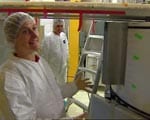Scientists debate whether prosthetic legs give Pistorius an unfair advantage in the 400-meter race
Book a live interview

To book a live or taped interview with Peter Weyand in the SMU News Broadcast Studio call SMU News at 214-768-7650 or email news@smu.edu. |
Related links
- Peter Weyand
- Journal of Applied Physiology: “The biological limits to running speed are imposed from the ground up”
- Part 1: Clarifications of the history of the case
- Part 2: The science of Oscar Pistorius’ advantage
- Annette Caldwell Simmons School of Education & Human Development
More SMU Research news
Scientific American has written a comprehensive piece on the long-running global controversy surrounding double-amputee South African runner Oscar Pistorius, the first amputee to compete in the Olympics.
The July 24 article “Should Oscar Pistorius’s Prosthetic Legs Disqualify Him from the Olympics?” quotes SMU’s Peter Weyand, an expert in human locomotion.
Controversy has swirled around Pistorius as the debate continues over the scientific advantage he enjoys as a result of his high-tech, carbon fiber artificial legs. Weyand helped lead a team of scientists who are experts in biomechanics and physiology in conducting experiments on Pistorius and the mechanics of his racing ability.
Weyand is widely quoted in the press for his expertise on human speed. He is an SMU associate professor of applied physiology and biomechanics in the Annette Caldwell Simmons School of Education & Human Development.
EXCERPT:
By Rose Eveleth
Scientific American
Runners who’ve faced off against Oscar Pistorius say they know when the South African is closing in on them from behind. They hear a distinctive clicking noise growing louder, like a pair of scissors slicing through the air—the sound of Pistorius’s Flex-Foot Cheetah prosthetic legs.
It’s those long, J-shaped, carbon-fiber lower legs—and the world-class race times that come with them—that have some people asking an unpopular question: Does Pistorius, the man who has overcome so much to be the first double amputee to run at an Olympic level, have an unfair advantage? Scientists are becoming entwined in a debate over whether Pistorius should be allowed to compete in the 2012 London Games.
Pistorius was born without fibulas, one of the two long bones in the lower leg. He was unable to walk as a baby, and at 11 months old both of his legs were amputated below the knee. But the growing child didn’t let his disability slow him down. At age 12 he was playing rugby with the other boys, and in 2005, at age 18, he ran the 400-meter race in 47.34 seconds at the South African Championships, sixth best. Now 25, the man nicknamed the “Blade Runner” has qualified for the 2012 Summer Olympics in London, just three weeks before the games were to begin. But should he be allowed to compete?
The question seems preposterous. How could someone without lower legs possibly have an advantage over athletes with natural legs? The debate took a scientific turn in 2007 when a German team reported that Pistorius used 25 percent less energy than natural runners. The conclusion was tied to the unusual prosthetic made by an Icelandic company called Össur. The Flex-Foot Cheetah has become the go-to running prosthetic for Paralympic (and, potentially Olympic) athletes. “When the user is running, the prosthesis’s J curve is compressed at impact, storing energy and absorbing high levels of stress that would otherwise be absorbed by a runner’s ankle, knee, hip and lower back,” explains Hilmar Janusson, executive vice president of research and development at Össur. The Cheetah’s carbon-fiber layers then rebound off the ground in response to the runner’s strides.
After the German report was released, the International Association of Athletics Federations (IAAF) banned Pistorius from competing. Pistorius hired Jeffrey Kessler, a high-powered lawyer who’s represented athletes from the National Basketball Association and National Football League. It soon became clear that the IAAF’s study was very poorly designed, so when Pistorius’s team asked for a new study they got it. Soon scientists gathered at Rice University to figure out just what was going on with Pistorius’s body.
The scientific team included Peter Weyand, a physiologist at Southern Methodist University who had the treadmills needed to measure the forces involved in sprinting. Rodger Kram, at the University of Colorado at Boulder, was a track and field fan who studied biomechanics. Hugh Herr, a double amputee himself, was a renowned biophysicist. The trio, and other experts, measured Pistorius’s oxygen consumption, his leg movements, the forces he exerted on the ground and his endurance. They also looked at leg-repositioning time—the amount of time it takes Pistorius to swing his leg from the back to the front. (…)
SMU is a nationally ranked private university in Dallas founded 100 years ago. Today, SMU enrolls nearly 11,000 students who benefit from the academic opportunities and international reach of seven degree-granting schools. For more information see www.smu.edu.
SMU has an uplink facility located on campus for live TV, radio, or online interviews. To speak with an SMU expert or book an SMU guest in the studio, call SMU News & Communications at 214-768-7650.
By Margaret Allen
Senior research writer, SMU Public Affairs
View Archive →
 Observed! SMU’s LHC physicists confirm Higgs ‘God particle’
Observed! SMU’s LHC physicists confirm Higgs ‘God particle’ DOE Award: advancing SMU’s link to the God particle
DOE Award: advancing SMU’s link to the God particle Ancient tree-ring records from southwest U.S. suggest today’s megafires are truly unusual
Ancient tree-ring records from southwest U.S. suggest today’s megafires are truly unusual Human diabetes has new research tool: Overfed fruit flies that develop insulin resistance
Human diabetes has new research tool: Overfed fruit flies that develop insulin resistance Modeling the human protein in search of cancer treatment: SMU Researcher Q&A
Modeling the human protein in search of cancer treatment: SMU Researcher Q&A Middle school boys who are reluctant readers value reading more after using e-readers
Middle school boys who are reluctant readers value reading more after using e-readers Dark matter search may turn up evidence of WIMPS: SMU Researcher Q&A
Dark matter search may turn up evidence of WIMPS: SMU Researcher Q&A Unconventional geothermal techniques a potential game changer for U.S. energy policy
Unconventional geothermal techniques a potential game changer for U.S. energy policy Study: Nearly two-thirds of EU citizens are marginalized by English-language dominance
Study: Nearly two-thirds of EU citizens are marginalized by English-language dominance